Estate Jewelry: The Horror
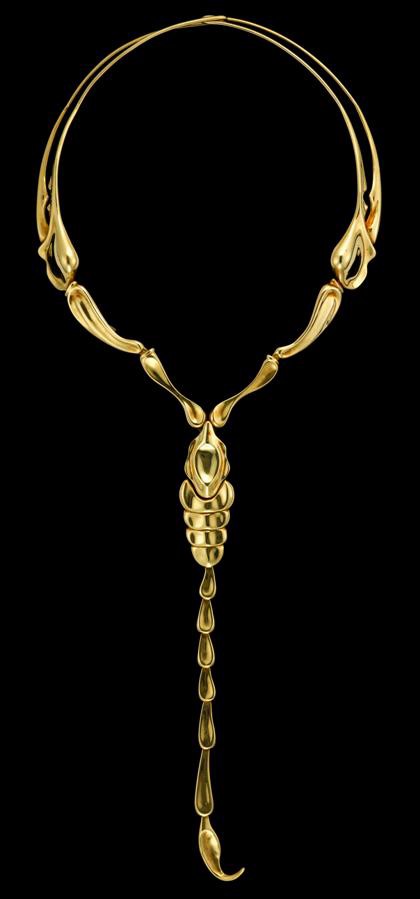
This 18k yellow gold “Scorpion” necklace, ca. 1978, was created by Italian designer Elsa Peretti for Tiffany & Co. The necklace, which is formed of interlocking segments, has a detachable tail, so that just the scorpion claws can be worn as a collar. It’s an iconic piece, and typical of the stripped-down, organic style of the designer. Peretti actually drew her inspiration for this piece from the scorpions living near her home in Catalonia, Spain, and the British Museum, which owns one of these necklaces in sterling silver, quotes her as saying “While working in Sant Martí Vell, I came across a lot of scorpions. The animals are incredibly attractive, with fascinating mechanics. Strangely they are never around when I need to review something in my design. I have to confess that I had to sacrifice a few. I feel sorry.”
Last month, Carine Roitfeld, former editor of French Vogue, paid homage to both Peretti and this necklace in a feature in the debut issue of her new magazine, CR Fashion Book. The New York Times relates the story of the designer’s slightly less-than-thrilled reaction to the photos here.
We may have seen the end of Peretti’s 38-year relationship with Tiffany & Co., however, as the two entities are currently battling over intellectual property rights. What will come of this remains to be seen, but in the meantime a variation of the scorpion necklace is still available through Tiffany — although it’s a watered-down version of the original.
This necklace is one of the most striking pieces of jewelry I’ve ever seen, and it’s not something that I, with a personal style best described as “disheveled,” would ever be able to pull off. But at an estimate of $2,000–4,000, the Scorpion is one of the more accessible pieces of design history, and will be included in the Fine Jewelry & Watches auction held on November 5 at Freeman’s in Philadelphia.
Don’t stop there, though, because there are a number of other interesting pieces in the sale, including a beautiful 3.4-carat cushion cut Kashmir sapphire ring (lot 6), a Salvador Dali-signed 18k “wing” bypass ring (lot 11), and a collection of wristwatches and pocket watches from the collection of the Philadelphia Museum of Art (lots 120–142).
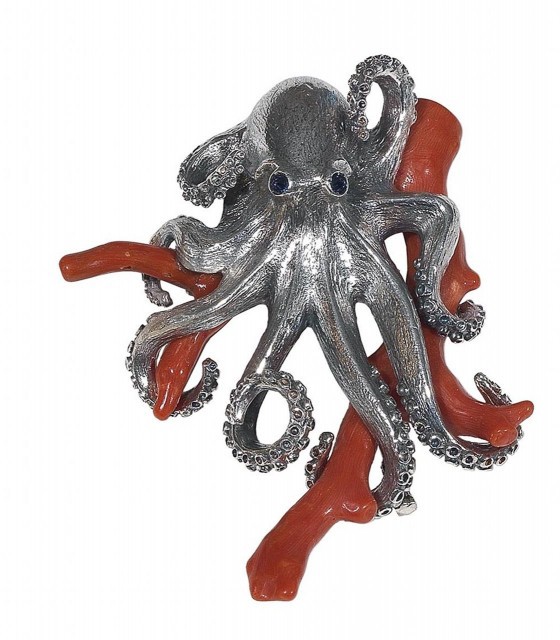
RELEASE THE KRAKEN! A platinum kraken with sapphire eyes, wreaking havoc amid coral branches! Or maybe he’s just a little octopus combination pin/pendant. YOU DECIDE.
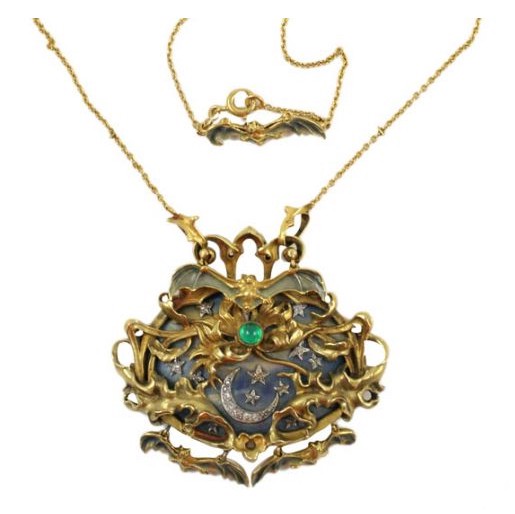
Bats flutter against a backdrop of the moon and stars in this eerily pretty French Art Nouveau necklace. Set in 18k gold with enamel, the moon and stars are comprised of diamonds, while the bats are hinged to add movement to the piece. Another smaller bat decorates the clasp. Circa 1900.
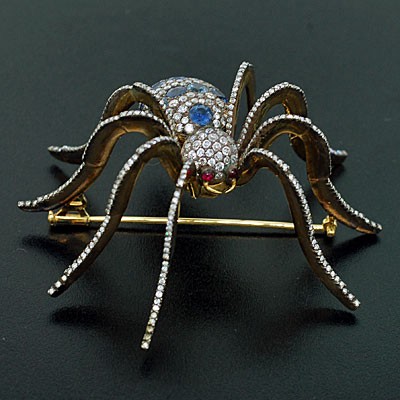
What’s Halloween without a giant spider? This 14kt yellow gold spider pin is approximately 2 5/8″ wide by 2 5/8″ tall. Each leg is lined with diamonds, while the body pairs over 2 carats of sapphires with diamond accents. The head is also diamond-set, with gold pinchers and cabochon ruby eyes.
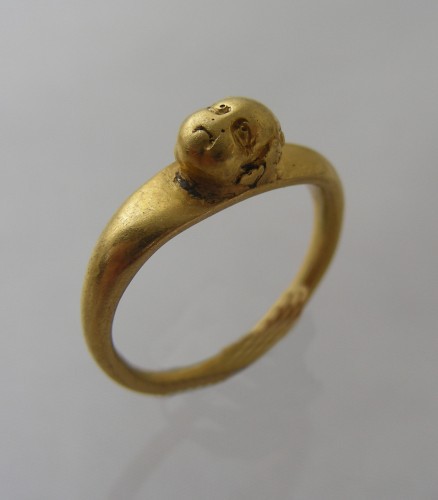
This ring, a rare survivor from first- or second-century Rome, depicts the head of Cupid in high-carat gold. The dealer describes Cupid here as a “chubby mischievous infant,” but, honestly, the little guy scares the hell outta me.
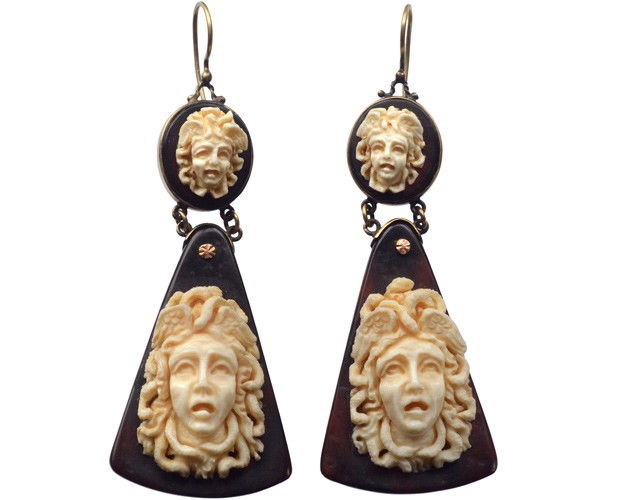
These earrings date to the 1870–80s, and feature finely carved ivory images of Medusa set on tortoiseshell. They’re very large — 3.25” in length — and were created in Italy.
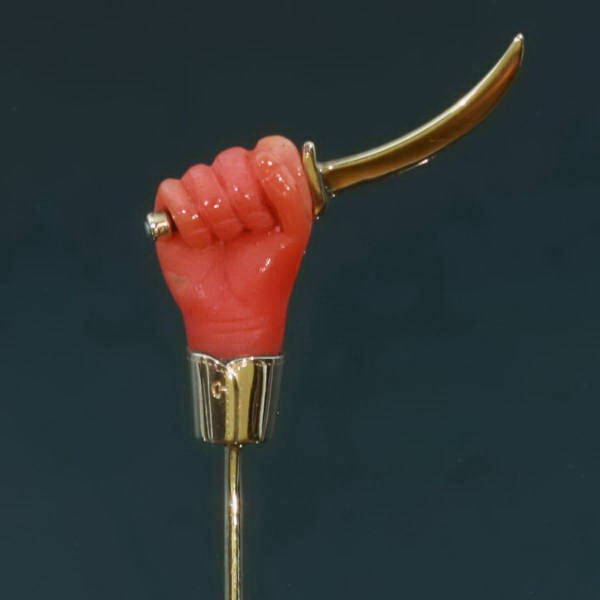
Circa 1870, this Victorian stickpin depicts a hand brandishing a knife/sword in 18k gold and coral. The knife is pointing the wrong way, but I still hear the Psycho music whenever I look at it.
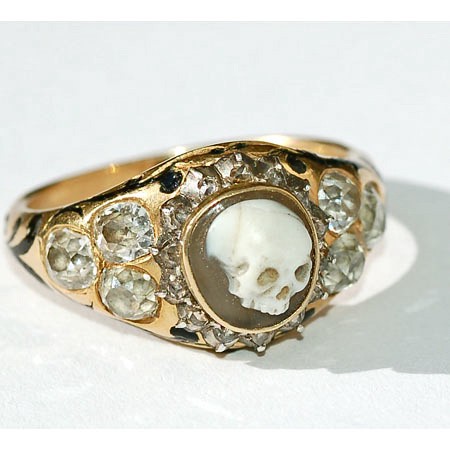
If this post goes live and this ring is still available, I’ll be shocked. As a memorial ring, it’s an exceptional piece: 18k gold with a carved agate skull surrounded by rose- and old-cut diamonds and black enameling, with hallmarks for London 1852. But as if that weren’t good enough, there’s an interior inscription on the ring that adds another fascinating layer of history: Inscribed “James Dixon Obit 1852,” it memorializes James Dixon, a well-known English silversmith and founder of the family firm of James Dixon & Sons.
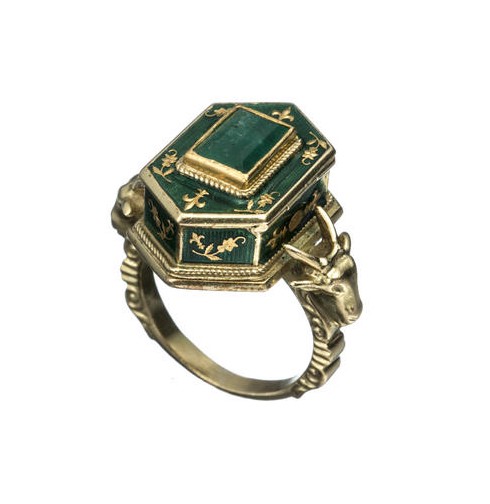
This fantastic Victorian “poison ring” is 18k gold, with a central casket flanked by two ram’s heads (an occult symbol all their own). The casket, which is enameled in green and set with a large emerald, opens to reveal a sizeable inner chamber that would easily meet all your poison-storage needs.
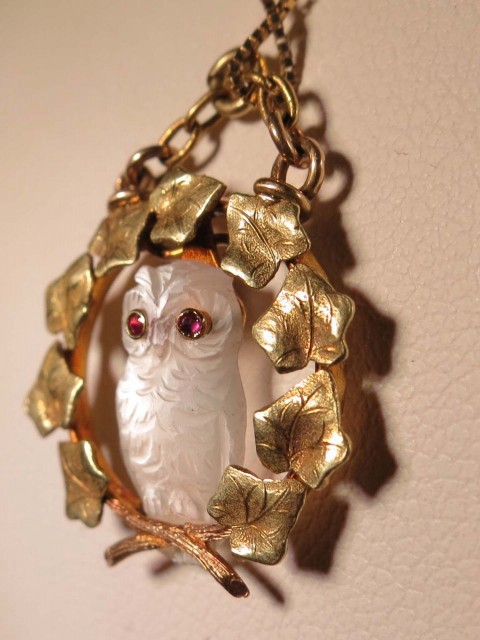
Owls are another Halloween standby (and they also had a pretty bad rep in the Middle Ages, apparently), but I particularly like them when they’re made of carved moonstone with ruby eyes, and perched amid 14k gold leaves. The pendant is unmarked but may have originated in England.
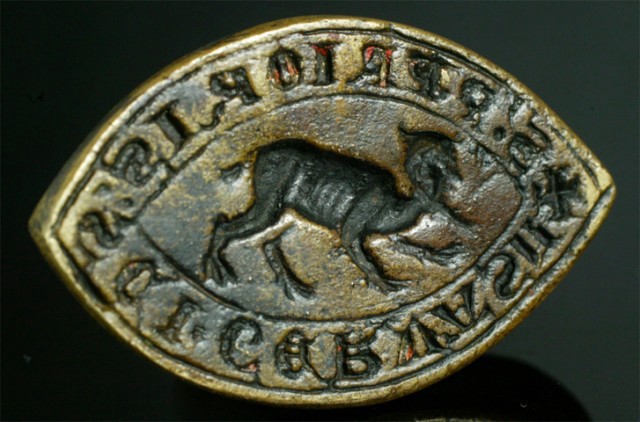
This French medieval bronze seal dates to the 13th century and features what the dealer describes as a “chimerical creature: a quadruped with a bearded human head.” (The head is more easily seen in the image of the wax impression; click through to view.) Whatever it is, it’s pretty odd. Around the creature are the words: “S. PRIORIS. SCI. GERVASII,” which translates to “seal of the prior of (the church) Saint-Gervais.” St. Gervais, along with his brother Protase, was an early Christian martyr, and the Priory of St. Gervais was built outside Rouen in 1087 and survived until the 15th century.
I have no idea what symbolic meaning the creature has in this piece, because I’m not even sure what it is. It’s similar to a Manticore, but the tail’s wrong, and the feet are a little weird, too. (Also, this has nothing to do with anything, but Pliny the Elder said that the Manticore has “a voice like the sound of a pan-pipe blended with a trumpet,” and the thought of that is KILLING me.) But anyway, I’m stumped. Any ideas, oh brilliant readers?
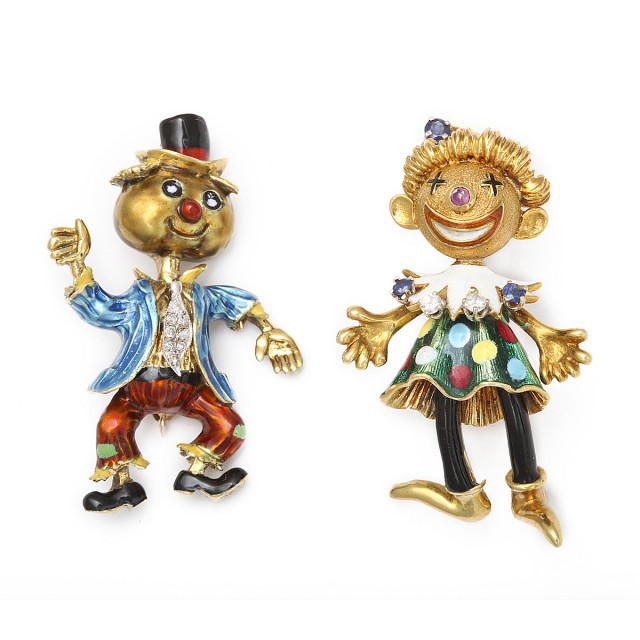
Circa 1940, these gold and enamel (with gemstone accents) brooches are American and feature a wealth of tiny details, like enamel patches on the pants of scarecrow, and brightly colored polka dots on the lady’s dress. Do you like clowns? I don’t. *shudder*
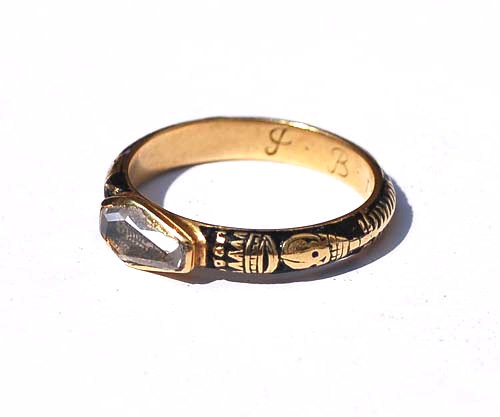
A full skeleton circles the band of this gold and enamel memento mori ring, circa 1727. A crown hovers above the skull, which, as the dealer notes, signifies that “death is the master of all.”
A crystal and gold coffin protects yet another skeleton, this one painted in gold on a black background. The inside of the band is engraved with the initials “JB” and the year 1727.
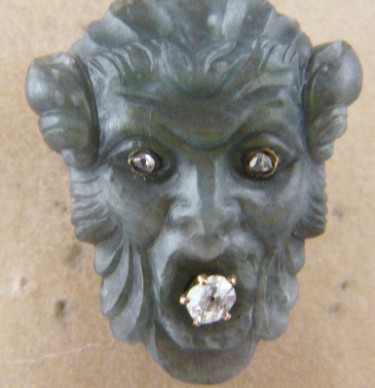
This carved labradorite grotesque face pin features rose-cut diamonds set in 14k gold. He’d be scarier if he didn’t look like Wolverine eating popcorn.
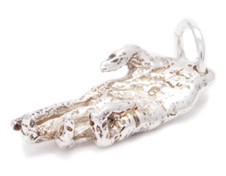
I could have posted an actual taxidermied monkey paw (gross, Etsy!) but instead I found a designer who’s making monkey paw charms in sterling silver and gold — so now I have an excuse to post one of my favorite scary stories of all time. Don’t open the door. DON’T OPEN THE DOOR!
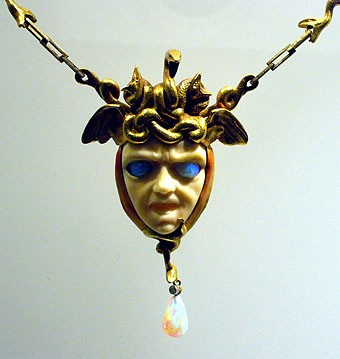
This Medusa pendant is easily the most terrifying item of jewelry I’ve ever seen. It’s not for sale (as far as I know), and I’m not even sure if it’s in private hands or a museum collection, but the image is floating around on the internet and it demands a mention. The pendant, circa 1898, was created by the Belgian jeweler and sculptor Philippe Wolfers (1858–1929). Wolfers was the son of a goldsmith, and he enjoyed a long, successful career. His work — which included sculpture, jewelry, glasswork, and ceramics — showed a progression of influences, including the Far East, Art Nouveau, and, later in life, Art Deco. Occasionally, his designs also delved into Symbolism, a movement (mirrored in literature by authors like Baudelaire and Huysmans) that rebelled against Realism to focus instead on dreams or the world of the imagination.
Wolfers is regarded today as one of the masters of the Art Nouveau style, but he’s not as well-known as others designers because he didn’t produce as much work. If you would like to see more of his creations, there’s a nice collection of images here (sorry, it’s in another language!).
Previously: Maritime Jewels.
Monica McLaughlin would also like to mention that there’s currently an exhibition of mourning jewelry running through January 2013 at the Massachusetts Historical Society in Boston. Check it out if you’re in the area, or browse the jewelry on their dedicated website.